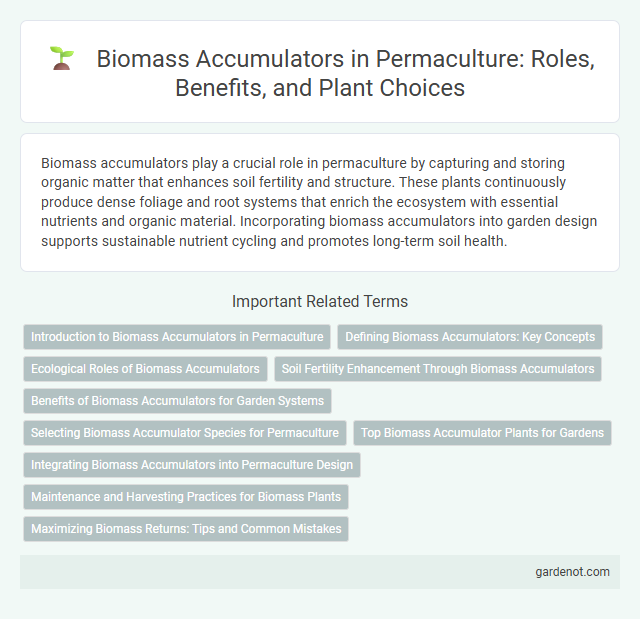Biomass accumulators play a crucial role in permaculture by capturing and storing organic matter that enhances soil fertility and structure. These plants continuously produce dense foliage and root systems that enrich the ecosystem with essential nutrients and organic material. Incorporating biomass accumulators into garden design supports sustainable nutrient cycling and promotes long-term soil health.
Introduction to Biomass Accumulators in Permaculture
Biomass accumulators in permaculture are plant species that efficiently capture and store nutrients in their leaves, stems, and roots, enhancing soil fertility and ecosystem sustainability. Common examples include comfrey, nettle, and dynamic accumulators like comfrey, which rapidly produce organic matter rich in nitrogen, potassium, and other essential minerals. Incorporating biomass accumulators improves nutrient cycling, supports companion planting, and reduces the need for synthetic fertilizers in sustainable agricultural systems.
Defining Biomass Accumulators: Key Concepts
Biomass accumulators are plants specifically selected for their ability to rapidly capture and store organic matter, enhancing soil fertility and ecosystem productivity in permaculture systems. These species efficiently sequester carbon, recycle nutrients, and build substantial organic layers through leaf litter, root biomass, and woody material. Integrating biomass accumulators like comfrey, nitrogen-fixing trees, and dynamic accumulators supports sustainable land management by boosting soil health and promoting biodiversity.
Ecological Roles of Biomass Accumulators
Biomass accumulators play a crucial role in permaculture by enhancing soil fertility through the continuous addition of organic matter, which improves nutrient cycling and water retention. These plants contribute to carbon sequestration, helping mitigate climate change by storing carbon in their biomass and root systems. Their presence supports biodiversity by providing habitat and food for beneficial insects and microorganisms, fostering a resilient and balanced ecosystem.
Soil Fertility Enhancement Through Biomass Accumulators
Biomass accumulators, such as comfrey and nettles, play a pivotal role in permaculture by capturing and concentrating nutrients from the soil and atmosphere. Their deep-root systems mine minerals and accumulate organic matter, which decomposes to enrich soil fertility and structure. Integrating these plants into garden systems enhances nutrient cycling, supports microbial activity, and reduces the need for external fertilizers.
Benefits of Biomass Accumulators for Garden Systems
Biomass accumulators enhance soil fertility by capturing nutrients and organic matter, which improves microbial activity and plant growth in garden systems. They contribute to sustainable water retention and erosion control by increasing ground cover and root biomass. Integrating diverse biomass accumulators supports biodiversity, pest regulation, and long-term ecosystem resilience in permaculture gardens.
Selecting Biomass Accumulator Species for Permaculture
Selecting biomass accumulator species for permaculture involves choosing fast-growing plants with high nutrient content and dense foliage, such as comfrey, alfalfa, and nitrogen-fixing shrubs. These species enhance soil fertility by accumulating essential minerals like nitrogen, potassium, and phosphorus, which are recycled through mulching or chop-and-drop techniques. Prioritizing native or well-adapted plants ensures resilience, reduces maintenance, and supports local biodiversity in permaculture systems.
Top Biomass Accumulator Plants for Gardens
Top biomass accumulator plants for permaculture gardens include comfrey, mustard, and sunflowers, renowned for their rapid growth and high nutrient content. Comfrey's deep roots mine minerals and its abundant leaves provide excellent mulch, while mustard acts as a green manure, suppressing weeds and enriching soil nitrogen. Sunflowers contribute substantial organic matter with their large leaf area and sturdy stems, enhancing soil structure and supporting beneficial microbial activity.
Integrating Biomass Accumulators into Permaculture Design
Integrating biomass accumulators such as comfrey, nettle, and borage into permaculture design enhances soil fertility by accumulating essential nutrients like nitrogen, potassium, and calcium. Strategic placement of these plants in guilds around fruit trees or vegetable beds supports nutrient cycling and promotes dynamic nutrient flow. Their rapid growth and compatibility with companion planting optimize sustainable biomass production and contribute to resilient ecosystem productivity.
Maintenance and Harvesting Practices for Biomass Plants
Biomass accumulators in permaculture require regular maintenance such as pruning and periodic thinning to promote vigorous growth and prevent overcrowding. Harvesting practices involve selectively cutting mature biomass for mulch, compost, or fodder, ensuring the continuous productivity of the plants. Timely removal of harvested material supports nutrient cycling and reduces pest infestation, optimizing the energy flow within the permaculture system.
Maximizing Biomass Returns: Tips and Common Mistakes
Maximizing biomass returns in permaculture involves selecting high-yield plant species such as comfrey, bamboo, and nitrogen-fixing legumes that rapidly accumulate organic matter. Ensuring optimal soil health with regular mulching, maintaining adequate moisture, and minimizing soil disturbance enhances biomass production and nutrient cycling. Common mistakes include neglecting plant diversity, overharvesting biomass before full growth, and failing to monitor pests and diseases that reduce plant vigor.
Biomass accumulator Infographic

 gardenot.com
gardenot.com